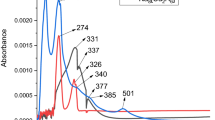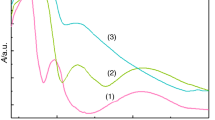Abstract
Three new coordinative compounds that contain mixed ligands (5,6-dimethylbenzimidazole and acrylato anion) were synthesized and characterized. The features of complexes have been assigned from microanalytical, IR, UV–Vis and EPR spectra as well as thermal analysis. IR data are in accordance with unidentate nature of 5,6-dimethylbenzimidazole while the acrilato ion acts as uni- or bidentate ligand. The electronic spectra display the characteristic pattern of square pyramidal or octahedral stereochemistry, which were confirmed by the EPR spectra. Antibacterial and antifungal activities of the complexes have been determined in vitro, against various Gram-negative and Gram-positive bacteria and fungi. The tested complexes exhibited different spectra of antimicrobial activity and inhibited the microbial ability to colonize the inert surfaces, acting as potential anti-adherence and biofilm-controlling agents. Thermal decomposition evidenced several well-defined steps as dehydration (complex 2), 5,6-dimethylbenzimidazole molecule release (all complexes) and the acrylate decomposition in carbonate (complex 3). The final residue is in all cases copper (II) oxide.







Similar content being viewed by others
References
Pawar NS, Dalal DS, Shimpi SR, Mahulikar PP. Studies of antimicrobial activity of N-alkyl and N-acyl 2-(4-thiazolyl)-1H-benzimidazoles. Eur J Pharm Sci. 2004;21:115–8.
Ören İ, Temiz Ö, Yalçin İ, Şener E, Altanlar N. Synthesis and antimicrobial activity of some novel 2,5-and/or 6-substituted benzoxazole and benzimidazole derivatives. Eur J Pharm Sci. 1998;7:153–60.
Machura B, Świtlicka A, Wolff M, Kusz J, Kruszynski R. Synthesis, spectroscopic characterization, X-ray structure and DFT calculations of copper(II) complex with 2-(2-pyridyl)benzimidazole. Polyhedron. 2009;28:1348–54.
Devereux M, O’Shea D, O’Connor M, Grehan H, Connor G, McCann M, Rosair G, Lyng F, Kellett A, Walsh M, Egan D, Thati B. Synthesis, catalase, superoxide dismutase and antitumour activities of copper(II) carboxylate complexes incorporating benzimidazole, 1,10-phenanthroline and bipyridine ligands: X-ray crystal structures of [Cu(BZA)2(bipy)(H2O)], [Cu(SalH)2(BZDH)2] and [Cu(CH3COO)2(5,6-DMBZDH)2] (SalH2 = salicylic acid; BZAH = benzoic acid; BZDH = benzimidazole and 5,6-DMBZDH = 5,6-dimethylbenzimidazole). Polyhedron. 2007;26:4073–84.
Saçzewski F, Dziemidowicz-Borys E, Bednarski PJ, Grünert R, Gdaniec M, Tabin P. Synthesis, crystal structure and biological activities of copper(II) complexes with chelating bidentate 2-substituted benzimidazole ligands. J Inorg Biochem. 2006;100:1389–98.
Zhou Q, Yang P. Crystal structure and DNA-binding studies of a new Cu(II) complex involving benzimidazole. Inorg Chim Acta. 2006;359:1200–6.
Arjmand F, Mohani B, Ahmad S. Synthesis, antibacterial, antifungal activity and interaction of CT-DNA with a new benzimidazole derived Cu(II) complex. Eur J Med Chem. 2005;40:1103–10.
Abdel Ghani NT, Mansour AM. Palladium(II) and platinum(II) complexes containing benzimidazole ligands: molecular structures, vibrational frequencies and cytotoxicity. J Mol Struct. 2011;991:108–26.
Kilcigil GA, Altanlar N. Synthesis and antifungal properties of some benzimidazole derivatives. Turk J Chem. 2006;30:223–8.
El-Sherif AA, Shoukry MM. Ternary copper(II) complexes involving 2-(aminomethyl)-benzimidazole and some bio-relevant ligands. Equilibrium studies and kinetics of hydrolysis for glycine methyl ester under complex formation. Inorg Chim Acta. 2007;360:473–87.
Ramanpreet W, Hedaitullah M, Naaz SF, Iqbal K, Lamba HS. Benzimidazole derivatives—an overview. IJPRC. 2011;1(3):565–70.
Patel RN, Gundla VLN, Patel DK. Synthesis, structure and properties of some copper(II) complexes containing an ONO donor Schiff base and substituted imidazole ligands. Polyhedron. 2008;27:1054–60.
Devereux M, McCann M, Shea DO, Kelly R, Egan D, Deegan C, Kavanagh K, McKee V, Finn G. Synthesis, antimicrobial activity and chemotherapeutic potential of inorganic derivatives of 2-(4′-thiazolyl)benzimidazole[thiabendazole]: X-ray crystal structures of [Cu(TBZH)2Cl]Cl·H2O·EtOH and TBZH2NO3 (TBZH = thiabendazole). J Inorg Biochem. 2004;98:1023–31.
Tavman A, Birteksöz S, Ötük G. Antimicrobial activity of 1,2-bis-[2-(5-R)-1H-benzimidazolyl]-1,2-ethanediols, 1,4-bis-[2-(5-R)-1H-benzimidazolyl]-1,2,3,4-butanetetraols and Their FeIII, CuII, and AgI complexes. Folia Microbiol. 2005;50(6):467–72.
Küçükbay H, Durmaz R, Güven M, Günal S. Synthesis of some benzimidazole derivatives and their antibacterial and antifungal activities. Arzneim Forsch Drug Res. 2001;51:420–4.
Özden S, Atabe D, Yildiz S, Göker H. Synthesis and potent antimicrobial activity of some novel methyl or ethyl 1H-benzimidazole-5-carboxylates derivatives carrying amide or amidine groups. Bioorg Med Chem. 2005;13:1587–97.
He Y, Wu B, Yang J, Robinson D, Risen L, Ranken R, Blyn L, Sheng S, Swayze EE. 2-Piperidin-4-yl-benzimidazoles with broad spectrum antibacterial activities. Bioorg Med Chem Lett. 2003;13:3253–6.
Kühler TC, Swanson M, Christenson B, Klintenberg AC, Lamm B, Fägherhag J, Gatti R, Ölwegård-Halvarsson M, Shcherbuchin V, Elebring T, Sjöström J. Novel structures derived from 2-[[(2-pyridyl)methyl]thio]-1H-benzimidazole as anti-Helicobacter pylori agents, part 1. J Med Chem. 2002;45(19):4282–99.
Carcanague D, Shue Y, Wuonola M, Uria-Nickelsen M, Joubran C, Abedi JK, Jones J, Kühler TC. Novel structures derived from 2-[[(2-pyridyl)methyl]thio]-1H-benzimidazole as anti-Helicobacter pylori agents, part 2. J Med Chem. 2002;45:4300–9.
Klimešová V, Kočí J, Pour M, Stachel J, Waisser K, Kaustová J. Synthesis and preliminary evaluation of benzimidazole derivatives as antimicrobial agents. Eur J Med Chem. 2002;37:409–18.
Téllez F, López-Sandoval H, Castillo-Blum SE, Barba-Behrens N. Coordination behavior of benzimidazole, 2-substituted benzimidazoles and benzothiazoles, towards transition metal ions. ARKIVOC. 2008;v:245–75.
Badea M, Olar R, Marinescu D, Vasile G. Some new acrylate complexes as a criterion in their selection for further co-polymerization reaction. J Therm Anal Calorim. 2005;80:683–5.
Badea M, Olar R, Marinescu D, Vasile G. Thermal behavior of some new complexes bearing ligands with polymerisable groups. J Therm Anal Calorim. 2006;85:285–8.
Badea M, Olar R, Marinescu D, Vasile G. Thermal behavior of some new triazole derivative complexes. J Therm Anal Calorim. 2008;92:209–14.
Badea M, Olar R, Marinescu D, Lazar V, Chifiriuc C, Vasile G. Thermal behaviour of new biological active cadmium mixed ligands complexes. J Therm Anal Calorim. 2009;97:781–5.
Mrozinski J, Heyduk E. Binuclear copper(II) complexes with α,β-unsaturated carboxylic acids. Part I. Copper acrylates with heterocyclic amine adducts. Polish J Chem. 1982;56:683–9.
Saviuc C, Grumezescu AM, Holban A, Bleotu C, Chifiriuc C, Balaure P, Lazar V. Phenotypical studies of raw and nanosystem embedded Eugenia carryophyllata buds essential oil antibacterial activity on Pseudomonas aeruginosa and Staphylococcus aureus strains. Biointerface Res Appl Chem. 2011;1:111–8.
Olar R, Badea M, Marinescu D, Chifiriuc C, Bleotu C, Grecu N, Iorgulescu EE, Bucur M, Lazar V, Finaru A. Prospects for new antimicrobials based on N,N-dimethylbiguanide complexes as effective agents on both planktonic and adherent microbial strains. Eur J Med Chem. 2010;45:2868–75.
Deacon GB, Philips JR. Relationships between the carbon–oxygen stretching frequencies of carboxylato complexes and the type of carboxylate coordination. Coord Chem Rev. 1980;33:227–50.
Badea M, Olar R, Marinescu D, Emandi A, Pop V, Vasile G. Complexes with acrylate ion as ligand. I. Polynuclear cromium (III) complexes. Nonlinear Optics Quantum Optics. 2004;32:127–34.
Nakamoto K. Infrared and Raman spectra of inorganic and coordination compounds. New York: Wiley; 1986.
Lever ABP. Inorganic electronic spectroscopy. Amsterdam: Elsevier; 1986.
Hathaway BJ, Billing DE. The electronic properties and stereochemistry of mono-nuclear complexes of the copper(II) ion. Coord Chem Rev. 1970;5:143–207.
Hathaway BJ. A new look at the stereochemistry and electronic properties of complexes of the copper(II) ion. Struct Bond. 1984;57:55–118.
Gaber M, El-Hefnawy GB, El-Borai MA, Mohamed NF. Synthesis, spectral and thermal studies of Mn(II), Co(II), Ni(II), Cu(II) and Zn(II) complex dyes based on hydroxyquinoline moiety. J Therm Anal Calorim. 2012;109:1397–405.
Acknowledgements
This paper was supported by the Sectorial Operational Programme Human Resources Development (SOP HRD), financed from the European Social Fund and by the Romanian Government under the contract number SOP HRD/107/1.5/S/82514.
Author information
Authors and Affiliations
Corresponding author
Rights and permissions
About this article
Cite this article
Vlaicu, I.D., Constand, M., Olar, R. et al. Thermal stability of new biologic active copper(II) complexes with 5,6-dimethylbenzimidazole. J Therm Anal Calorim 113, 1369–1377 (2013). https://doi.org/10.1007/s10973-013-2948-z
Received:
Accepted:
Published:
Issue Date:
DOI: https://doi.org/10.1007/s10973-013-2948-z




